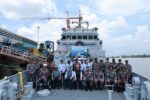The Boeing MQ-28A Ghost Bat program, developed in partnership with the Royal Australian Air Force (RAAF), has reached a major milestone with the successful completion of Capability Demonstration 2025. The trials proved not only the aircraft’s autonomous combat potential but also its ability to operate in a multi-ship formation, integrate with manned platforms, and deploy from forward bases. This makes Ghost Bat one of the most advanced Collaborative Combat Aircraft (CCA) programs in the world.
Operational Demonstrations
During the first half of 2025, Boeing and the RAAF executed a wide campaign to validate the Ghost Bat’s mission readiness. Key highlights include:
- Autonomous mission execution: The MQ-28A successfully completed complex tasks without continuous operator control.
- Multi-ship operations: Demonstrations with multiple Ghost Bats showed the ability to generate “combat mass.”
- Forward deployment: Aircraft operated from RAAF Base Tindal in the Northern Territory, outside the usual Woomera test range.
- Manned teaming: The Ghost Bat integrated with the E-7A Wedgetail AEW&C aircraft, extending surveillance and sensor coverage.
- Data fusion: Real-time information was shared between Ghost Bats and with manned platforms.
By September 2025, the program had accumulated over 150 flight hours and 20,000+ simulated hours, finishing four months ahead of schedule. The next milestone is a planned live air-to-air weapon release in late 2025 or early 2026.
Technical Features
The MQ-28A is designed as a flexible, affordable force multiplier for crewed aircraft.
- Length: 11.7 m
- Wingspan: 7.3 m
- Range: Over 2,000 nautical miles (≈ 3,700 km)
- Engine: Single turbofan, high subsonic speed
- Payload flexibility: Modular nose section allows rapid swapping of ISR, EW, or combat mission packages
- Autonomy: AI-driven behaviors, open systems architecture for future upgrades
This architecture ensures adaptability to evolving missions, from reconnaissance and electronic warfare to strike support.
Strategic Importance
The Ghost Bat is the first combat aircraft designed and built in Australia in over 50 years, marking a leap in sovereign defense capabilities.
- Operational value: Provides risk-sharing for manned aircraft, especially in high-threat environments.
- Force multiplier: Increases ISR coverage, electronic attack options, and strike potential without committing costly manned jets.
- Industrial impact: Boeing has established a local production facility in Queensland for Block 2 Ghost Bats, which will include enhanced survivability and mission capabilities.
- Regional role: For the Indo-Pacific, Ghost Bat represents a deterrent against peer adversaries, offering distributed and flexible combat power.
Challenges Ahead
Despite rapid progress, several challenges remain:
- Export potential: Interest is high among allies, but integration with other nations’ C2 and communications systems could be complex.
- Weapons integration: Combat credibility hinges on the successful demonstration of weapons release.
- Survivability: Effectiveness in contested airspace depends on stealth, EW resilience, and counter-SAM measures.
- Cost vs. sustainability: While cheaper than manned fighters, lifecycle costs for autonomy, sensors, and sustainment remain uncertain.
Expert Review
Pros
- Rapid development and early mission success
- Modular, open-architecture design
- Strong synergy with manned platforms
- Boost to Australia’s defense industry and sovereignty
Cons
- Weapons integration unproven
- Survivability against advanced IADS not fully disclosed
- Export and interoperability uncertainties
Rating: 4.0 / 5.0 – A groundbreaking system with strong potential, awaiting proof of combat lethality.
Key Points
- Ghost Bat completed trials ahead of schedule
- Validated autonomy, manned teaming, forward deployment
- 150 flight hours, 20,000+ simulated hours to date
- Weapon test planned for 2025/26
- Marks Australia’s return to combat aircraft design









